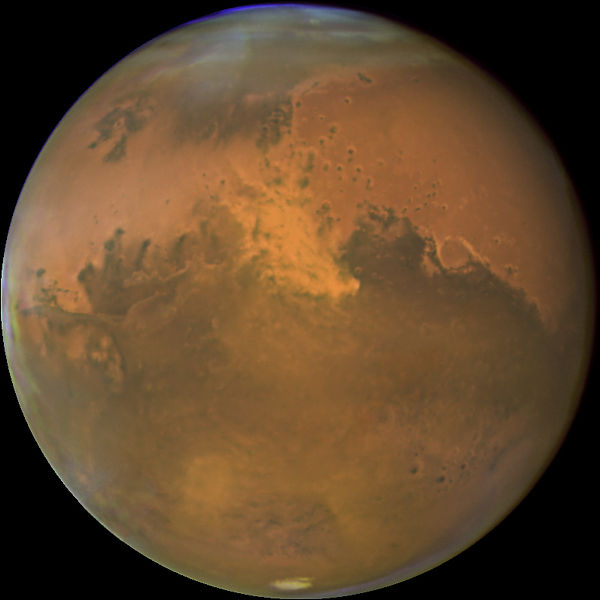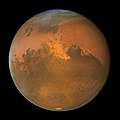Lêer:2005-1103mars-full.jpg

Grootte van hierdie voorskou: 600 × 600 piksels. Ander resolusies: 240 × 240 piksels | 480 × 480 piksels.
Oorspronklike lêer (800 × 800 piksels, lêergrootte: 232 KG, MIME-tipe: image/jpeg)
Lêergeskiedenis
Klik op die datum/tyd om te sien hoe die lêer destyds gelyk het.
| Datum/Tyd | Duimnaelskets | Dimensies | Gebruiker | Opmerking | |
|---|---|---|---|---|---|
| huidig | 16:52, 19 Junie 2009 |  | 800 × 800 (232 KG) | Tryphon | Higher resolution. |
| 01:21, 1 Januarie 2006 |  | 700 × 700 (34 KG) | Pringles | NASA's Hubble Space Telescope snapped this picture of Mars on October 28, within a day of its closest approach to Earth on the night of October 29. Hubble astronomers were also excited to have captured a regional dust storm on Mars that has been growing |
Lêergebruik
Die volgende bladsy gebruik dié lêer:
Globale lêergebruik
Die volgende ander wiki's gebruik hierdie lêer:
- Gebruik in beta.wikiversity.org
- Gebruik in bg.wikipedia.org
- Gebruik in ca.wikipedia.org
- Gebruik in el.wikipedia.org
- Gebruik in en.wikipedia.org
- Gebruik in en.wikiquote.org
- Gebruik in en.wikiversity.org
- User:Marshallsumter/Radiation astronomy1/Planets/Sciences
- User:Marshallsumter/Radiation astronomy2/Reds
- User:Marshallsumter/Radiation astronomy/Chemistry
- User:Marshallsumter/Radiation astronomy1/History
- Solar System, technical/Classical planets
- User:Marshallsumter/Keynote lectures (draft)/Meteor radiation astronomy
- User:Marshallsumter/Radiation astronomy1/Planets/Classicals
- Draft:Original research/Planets
- User:Marshallsumter/Radiation astronomy2/Visuals/Quiz
- User:Marshallsumter/Rocks/Rocky objects/Astronomy
- User:Marshallsumter/Radiation astronomy/Courses/Principles/Hourly 2
- User:Marshallsumter/Radiation astronomy/Courses/Principles/Midterm quiz
- User:Marshallsumter/Radiation astronomy/Courses/Principles/Final quiz
- Titan/Quiz
- User:Marshallsumter/Rocks/Rocky objects
- Draft:Enceladus/Quiz
- Moon/Quiz
- Stars/Sun/Heliology/Quiz
- Earth/Quiz
- User:Marshallsumter/Radiation astronomy/Clouds
- User:Marshallsumter/Radiation astronomy/Cryometeors
- User:Marshallsumter/Radiation astronomy1/Lithometeors
- Stars/Reds/Quiz
- Draft:Dione/Quiz
- User:Marshallsumter/Radiation astronomy2/Scattered disks/Quiz
- User:Marshallsumter/Radiation astronomy1/Kuiper belts/Quiz
- WikiJournal Preprints/Cryometeors
- Gebruik in es.wikipedia.org
- Gebruik in fa.wikipedia.org
- Gebruik in fr.wikipedia.org
- Gebruik in fr.wikinews.org
- Gebruik in gn.wikipedia.org
- Gebruik in hi.wikipedia.org
- Gebruik in hu.wikipedia.org
Wys meer globale gebruik van die lêer.

